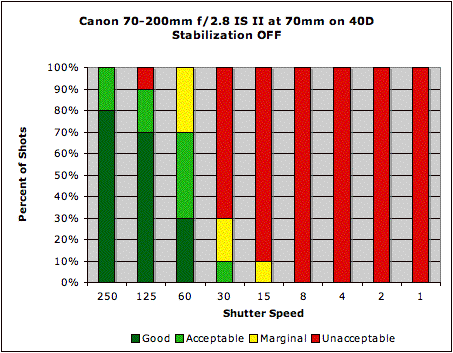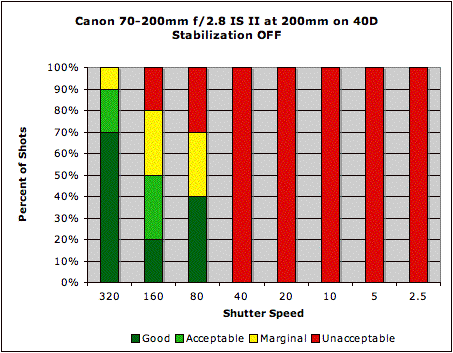Canon has been through a number of generations of image stabilization systems now, and the maturity of their technology shows in the 70-200mm f/2.8 IS II's performance. At 70mm with an already fairly steady shooter, we found that it delivered a bit over three stops of shake reduction. At the wider end of its range, IS performance degrades relatively gradually, in that the percentage of sharp shots decreases steadily over a range of 3-4 stops of shutter speed. This means you may still get a small percentage of "keepers" even at shutter speeds more than 3 stops beyond your normal "safe" hand-holding range. This contrasts with some lenses and camera bodies that seem to maintain a high percentage of good shots to a certain shutter speed range, and then run out of steam fairly quickly. As we'll see below, this lens more closely follows this second behavior at the 200mm end of its range.
 |
| Mouse over this chart to show results with IS activated. |
At 200mm, the shake reduction was comfortably four stops, Canon's claimed level of performance. It's actually fairly rare to see lenses delivering the full amount of shake reduction claimed by their manufacturers, so the Canon 70-200mm f/2.8 IS II is a rare bird, indeed. Our main lens tester Rob is a very stable shooter, but the size and weight of this lens took a toll even on him, as witness that only 50% of his shots were acceptably sharp at 200mm and 1/160 second with the IS turned off. With the IS on, though, 70% of his shots were tack-sharp and an additional 10% acceptably sharp at 1/10 second. That deserves repeating: 80% of shots were sharp at 200mm, handheld at 1/10 second. That's just flat-out amazing. When it does finally run out of motion-compensation ability, though, it happens fairly rapidly: The percentage of keepers went from 80% at 1/10 second to just 20% at 1/5 second.
 |
| Mouse over this chart to show results with IS activated. |
IS systems tend to provide more benefit to less-stable shooters than very steady ones, so most users will see the same or greater amounts of shake reduction as we measured here. You can read more about our IS test methodology here: SLRgear IS Test Methodology, v2.